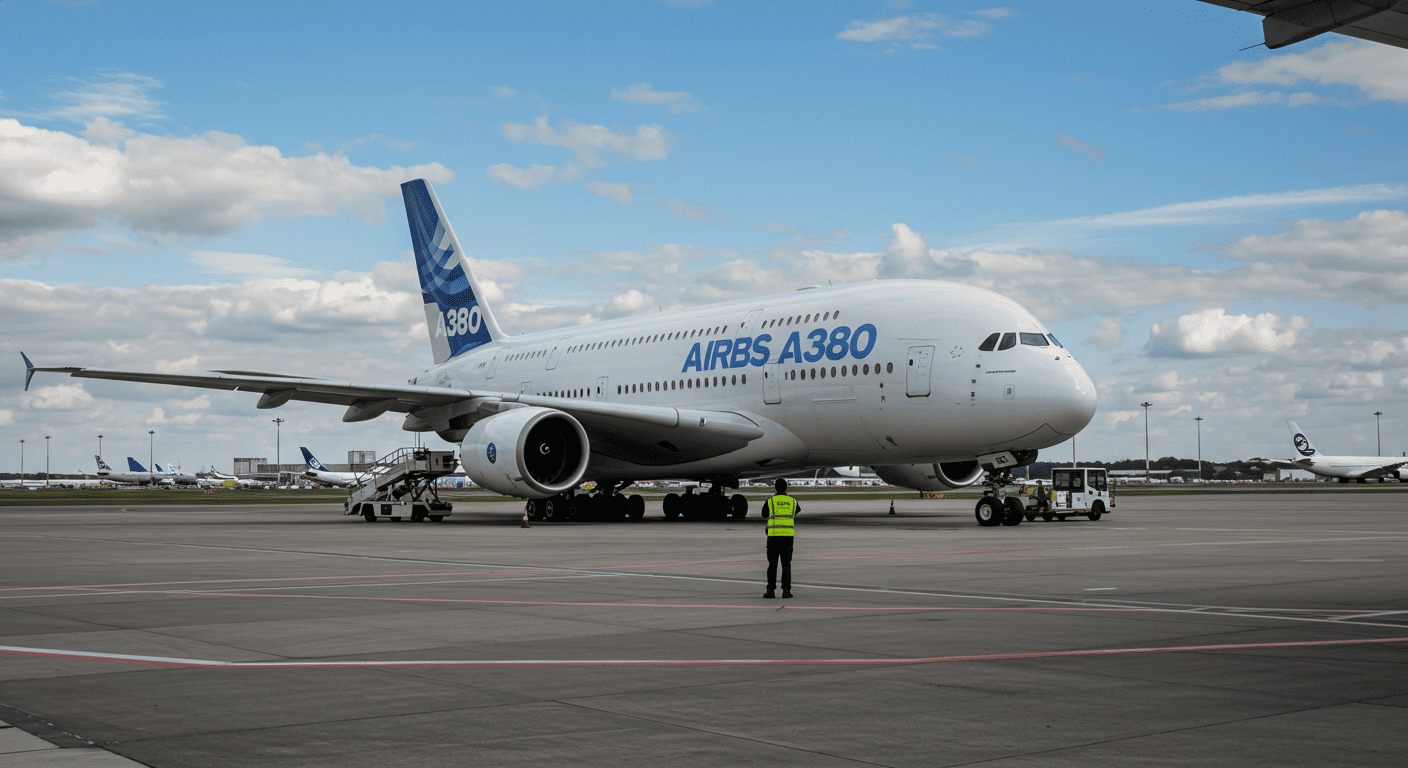The Airbus A380-800 is an unforgettable giant, easily recognized by its full-length double-deck design that transformed long-haul travel. While famous for luxury features like onboard lounges, its engineering is just as impressive, from its massive wingspan to its quiet, efficient engines. Here’s a closer look at its detailed specifications and the unique features that set it apart.
Overview of the Airbus A380—800
The Airbus A380-800 is the world’s largest passenger aircraft, defined by a full-length double-deck design that offers exceptional space. Its colossal scale creates a unique travel experience across two floors, typically seating over 500 passengers in a multi-class layout.
Four high-performance engines give the A380-800 an exceptional range, enabling it to connect major global hubs on ultra-long-haul routes. For instance, it can comfortably fly non-stop from Hong Kong to New York, making it a key aircraft for airlines on high-demand international flights.
Beyond its sheer size, the A380-800 also demonstrates innovative engineering. To manage its weight, Airbus extensively used advanced materials like carbon-fiber composites.
Specifications of the Airbus A380—800
While the A380-800’s immense size is its most visible trait, its technical specifications reveal the engineering behind its performance. These figures define everything from its flight capabilities to the airport infrastructure required to support it.
- Dimensions:
- Length: 72.72 m (238 ft 7 in)
- Wingspan: 79.75 m (261 ft 8 in)
- Height: 24.09 m (79 ft 0 in)
- Capacity:
- Typical Seating: 525 passengers (three-class)
- Maximum Certified Capacity: 853 passengers (all-economy)
- Performance:
- Cruising Speed: Mach 0.85 (approx. 903 km/h; 561 mph)
- Range: 15,200 km (8,200 NMI; 9,400 mi)
- Service Ceiling: 13,136 m (43,100 ft)
- Weight and Power:
- Maximum Takeoff Weight (TOW): 575 tonnes (1,268,000 lbs)
- Engines: Four Rolls-Royce Trent 900 or Engine Alliance GP7200 turbofans
These specifications are the foundation of the A380’s operational capabilities. Its massive takeoff weight is supported by four powerful engines, enabling it to connect distant continents without refueling.
Features of the Airbus A380—800
The Airbus A380-800 is more than its impressive dimensions; its advanced features deliver high efficiency, passenger comfort, and environmental responsibility. These elements make the superjumbo not just large, but highly sophisticated.
A key advantage is its exceptional fuel efficiency per passenger. By carrying more travelers than any other commercial aircraft, the A380 achieves a lower fuel burn per seat, which directly reduces its environmental footprint and makes it an economically sound choice for high-demand routes.
Despite its four powerful engines, the A380 is one of the quietest wide-body aircraft ever built. Its advanced engine technology and aerodynamic design drastically cut noise pollution, both inside the cabin and for communities near airports.
The A380’s large cabin provides exceptional comfort and space. Passengers benefit from wider seats, more personal space, and a smoother ride due to the aircraft’s size and stability. Additionally, its advanced air circulation systems, which refresh the cabin air every two to three minutes, help reduce travel fatigue on long-haul journeys.
Seating Arrangements in the Airbus A380—800
Airlines gained significant flexibility from the A380-800’s full-length double-deck design. This two-story layout created a massive interior volume, allowing carriers to introduce unique, comfort-oriented spaces that transformed the long-haul travel experience.
Airlines typically used the two decks to create distinct zones for different travel classes. The wider main deck usually housed most of the Economy Class seats—often in a spacious 3-4-3 layout—along with Premium Economy.
Although certified for up to 853 passengers, no airline ever implemented such a high-density layout. Instead, carriers prioritized comfort, typically opting for spacious three- or four-class configurations for 450–550 passengers, leaving room for unique amenities.
This spatial freedom led to innovative social areas and features previously not feasible on a commercial plane. Emirates, its largest operator, famously installed onboard lounges, bars, and even Shower Spas for premium passengers. These luxurious amenities transformed the aircraft from a mode of transport into a destination, setting a new benchmark for in-flight luxury.
Airbus A380—800 Operators
The A380-800 was operated by a select group of the world’s leading airlines, with notable carriers including:
- Emirates: The largest operator, with a fleet of over 100 A380s.
- Singapore Airlines: The launch customer for the aircraft.
- Lufthansa
- Qantas
- British Airways
These airlines strategically deployed the A380 on high-density, long-haul routes connecting major international hubs like London to Dubai or Sydney to Los Angeles.
Although Airbus concluded A380 production in 2021, the aircraft remains a prominent fixture in global aviation. Existing operators continue to fly their fleets, with many investing in significant cabin refurbishments to extend their service life.
Technological Innovations in the Airbus A380—800
The Airbus A380-800 was more than an achievement in scale; it was a platform for pioneering aerospace technology. Its design introduced key innovations in efficiency, weight reduction, and operational performance.
The extensive use of advanced materials was essential. To manage its immense weight, Airbus built the airframe with significant amounts of carbon-fiber reinforced plastic (CFRP) and next-generation aluminum-lithium alloys. These composites, comprising roughly 25% of the structure, were critical for shedding weight, directly improving fuel efficiency and extending its range.
The A380 also changed the design process. It was the first commercial aircraft developed using a full digital mock-up, allowing engineers to simulate and perfect every component virtually before manufacturing began. This digital approach not only enhanced engineering precision but also streamlined the complex assembly process.
Its operational systems were also innovative. The A380 introduced the Brake-to-Vacate (BTV) system, a smart technology that automatically manages deceleration to help pilots reach a pre-selected runway exit, optimizing runway usage. Such advancements didn’t just improve performance; they also contributed to more sustainable aviation goals, setting a new standard for very large aircraft.
The History of the Airbus A380—800
The development of the Airbus A380-800 was driven by bold ambition and groundbreaking engineering. It began in the 1990s as a direct response to growing congestion at major international airports, with the goal of creating an aircraft that could carry more passengers than any before it to reduce the number of flights on high-demand routes.
After years of intensive development, the A380 took to the skies for its maiden flight on April 27, 2005, in Toulouse, France. The event was a significant moment in aviation history, showcasing the result of innovative design and manufacturing.
The A380 entered commercial service with Singapore Airlines in 2007 and quickly became a passenger favorite, celebrated for its quiet, smooth ride and luxurious amenities.
However, the limited market for such a large aircraft prompted Airbus to end A380 production, and the final superjumbo was delivered in 2021.
Read more:
- Airbus A320: Specifications, Features, and Seat Maps
- Airbus A340-300: Features, Specifications, and Performance
- Airbus A220: Features, Specs, and Benefits of the A220 Family
- Airbus Beluga: The Unique Transport Aircraft
- Airbus A340-600: Features, Specifications, and Performance
- Airbus A350: Features, Specs, and Innovations
- Airbus A319: Specifications, Seat Maps, and Features
- Airbus A321neo: Features, Specs, and Benefits
- Airbus A321: Specifications, Features, and Seat Maps
- Airbus A380: The Ultimate Guide to the World’s Largest Passenger Aircraft
- Airbus A330-300: Specifications, Seat Maps, and Amenities
- Airbus A350-900: Features, Specs, and Seating Guide
- Airbus A330: Specifications, Features, and Seat Maps

